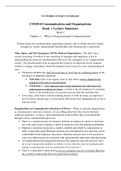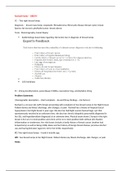VITTORIO CESCHI’S SUMMARY
CM1014-Communication and Organizations
Book + Lecture Summary
Week 1
Chapter 1 – What is Organizational Communication?
Human beings are communicating, organizing creatures, and we define ourselves largely
through our various organizational memberships and communicative connections
Time, Space, and The Emergence Of The Modern Organization – The shift from a
society consisting of workers to one consisting of managers and employees is key to
understanding the historical transformations that led to the emergence of an “organizational
society”; the transformation from an agriculturally based to an industrial society required
workers to change work habits, which development can be traced to a new understanding of
time
➢ Thompson identifies the shift from task time to clock time as a defining feature in the
emergence of industrial capitalism
• Task time refers to an organic sense of time where work is shaped by the
demands of the tasks to be performed
• Clock time is a new imposed sense of time marked by the shift from self-
employment to working for others, essential to the development of systematic
forms of mass production; not anymore passing time but spending time
➢ Even today, clock time is still the defining feature of work for many; an employee’s
level of power and prestige is at least partly reflected by how independent he or she is
from the clock
Organizations as Communicative Structures of Power – When we describe organizations
as communicative structures of power, we are talking about how the tensions between
employee autonomy, or agency, and organizational control efforts play out dynamically
through various communication processes
➢ There is a constant tension, for instance, between an employee’s desire to maximize
her or his salary and a company’s desire to minimize costs and maintain profitability
➢ Employee emotional expression is usually carefully prescribed by organizations in
order to meet their goals→humans emotions are rationalized in ways that may not be
comfortable for the employee; the point is that these tensions have to be resolved in
some way which need to be consistent with organizational rather than individual goals
➢ All organizational and management theories thus implicitly pose the question “How
do we get organization members to behave in ways that they may not spontaneously
engage in and that may even be against their best interests?”
➢ Thus, it is important to think about power as a dynamic process of struggle that rests
on a complex relationship between control and resistance
,Defining Organizational Communication – W. Charles Redding, widely regarded as the
founder of the field of organizational communication, argues that complex organizations
exhibit the following four essential features:
1. Interdependence
2. Differentiation of tasks and functions
3. Goal orientation
4. Control
He did not include communication as a defining feature; however, we will examine this with
a fifth element: the communication-organization relationship
The Communication-Organization Relationship – One of the main problems in defining
this term is that we’re dealing with two phenomena (communication and organization); we
hence discuss the following two perspectives:
➢ Communication in Organizations: this approach is largely technical and focuses on
questions of efficiency and clarity; organizations are seen as relatively stable,
physical structures within which communication occurs (transmission model)
• Here, issues related to noise, channel, information content and redundancy are
seen as key factors to take into account when thinking about effective
organizational communication
➢ Organizations as Communication: this second approach, which is the one adopted
throughout the book, views organizations as complex patterns of communication
habits; organizations are not simply containers within which people communicate,
rather, they exist because people communicatively create the complex system of
meaning that we call organizations; without communication, organizations cease to
exist as meaningful human collectives (constitutive approach)
Although there are multiple definitions and conceptions of communication, we adopt a
meaning-centered perspective; we define communication as the dynamic, ongoing process of
creating and negotiating meanings through interactional symbolic (verbal and nonverbal)
practices, including conversation, metaphors, rituals, stories, dress, and space
➢ We can define organizational communication as the process of creating and
negotiating collective, coordinated systems of meaning through symbolic practices
oriented toward the achievement of organizational goals
Interdependence - all complex organizations consist of intricate webs of interconnected
communication activities, the integration of which determines the success or failure of the
organization → no member can function without affecting, and being affected by, other
organization members; mutual dependence for successful organizational practice
Differentiation of Tasks and Functions - all organizations operate according to the
principle of division of labour, in which members specialize in particular tasks and the
organization as a whole is divided into various departments
• Division of labor: members specialize in particular tasks and the organization as a
whole is divided into various departments.
,• Scientific management: analyzed each organizational task to determine the most
efficient and productive way to work.
• Bureaucracy: made sure that each person knew their place in the organization by
creating a rational system of ‘offices’ that defined each work role.
Goal Orientation – whether non-profit or for-profit, organizations are oriented toward
particular goals; organizations, however, often have multiple competing goals; sometimes,
company goals can conflict with those of other interest groups, such as community members,
employees, or shareholders
Control Processes – control is a central, defining feature of complex organizations; we will
outline five different control processes that have evolved since the emergence of the
industrial capitalist organization in the late 19th century
➢ Direct Control – directing employees in explicit ways and then monitor their
behaviours to make sure they are performing adequately; superior-subordinate
relations, where the former has the authority to coerce the latter into working in
specific ways
➢ Technological Control – involves the implementation of various forms of
organizational technology to control worker productivity; the forms of technological
control have changed as our economy has shifted from heavy production to a service
economy; in a service-oriented economy, customers too are subject to technological
control (i.e. ordering a BigMac from the touchscreen instead of a real person)
• Foucault refers to technological control in the form of electronic surveillance
with the term panopticism
➢ Bureaucratic Control – enables organization members to gain advancement on merit
rather than based on connections; the creation of bureaucratic control mechanisms
(i.e. formal rules, job descriptions, merit systems…) promoted a more democratic
workplace where employees were less subject to the arbitrary whims of supervisors;
bureaucratic systems can also be very alienating, however
➢ Ideological Control – requires little direct supervision of employees, as it focuses on
the corporate development of a system of values, beliefs, and meanings with which
employees are expected to identify strongly; this form of control develops identities
that are connected with the goals and values of the company for which they work
➢ Biocratic Control – shifts the focus away from conformity, instead attempting to
capture the diversity of its workforce; rather than attempting to limit worker autonomy
through various forms of control, companies now aims to enlist the whole employee,
asking workers to “just be yourself” at work, erasing the distinction between work and
home, or leisure;
• As work more and more frames our lives, individuals constantly engage in
behaviours where the creation and continual improvement of an
“entrepreneurial self” is the goal, so that everything becomes an extension of
our desire to be economically competitive
, • Biocratic control is more difficult to escape than others because it
encompasses all aspects of life and makes work and social identities
increasingly inseparable
As a brief sum up of the five forms of control, is good to remember that:
▪ Many organizations use multiple forms of control at the same time
▪ Control occurs via active consent; direct is the more coercive, biocrative the least
▪ Each form of control tends to develop in response to the failure of earlier forms of
control to adequately deal with employee autonomy and resistance
▪ Direct, technological, and bureaucratic forms of control rely mainly on a fairly simple
understanding of communication as information transmission, while ideological and
biocratic forms of control depend on a view of communication as complex and central
to the construction of employee identities and organizational meaning systems
Communication, Organization, and Work – work, and particularly working for a living, is
very much a defining feature of our lives, representing a dominant part of the social
imaginary that shapes who we are and our connection to the broader society in which we live;
at the same time, work in the 21st century is increasingly both insecure and unsatisfying
➢ Weber points out that in traditional, pre-capitalist societies people worked to live, or
to earn enough to maintain themselves and their families; today we live to work
➢ Gig economy – term coined at the height of the 2009 financial crisis, when many
people were forced to make multiple, typically low-paying jobs with few or no
benefits→freelance; this concept is related to what today is freelancing or self-
employment (i.e. Uber, Airbnb,, Deliveroo…)
Three types of communication
Grapevine communication: gossip, informal, ‘during a coffee break’.
Line communication – 4model: one-way, direct communication. SMCR: Sender, Message,
Channel, Receiver – i.e. manager to employer
Parallel communication: helps the communication process with newsletters, magazines,
websites, videoclips; still formal.






